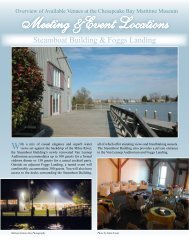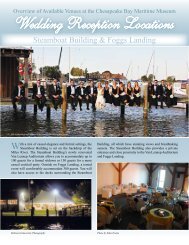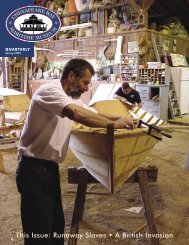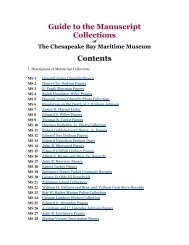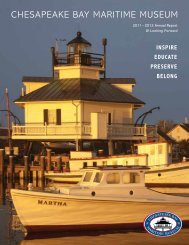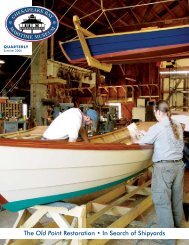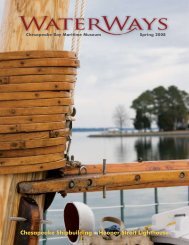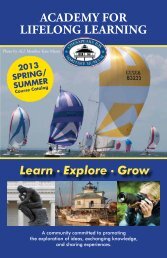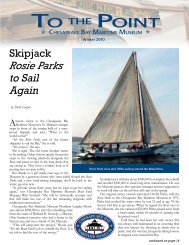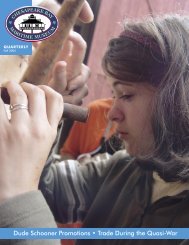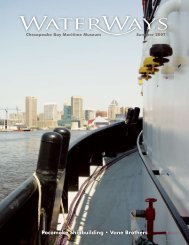Fall 2008 - Chesapeake Bay Maritime Museum
Fall 2008 - Chesapeake Bay Maritime Museum
Fall 2008 - Chesapeake Bay Maritime Museum
Create successful ePaper yourself
Turn your PDF publications into a flip-book with our unique Google optimized e-Paper software.
On the Cover<br />
WaterWays<br />
<strong>Fall</strong> <strong>2008</strong><br />
Volume 6 Number 2<br />
Editor<br />
Michael Valliant<br />
editor@cbmm.org<br />
Graphic Design/Photography<br />
Rob Brownlee-Tomasso<br />
Contributors<br />
Julie Barnett<br />
Dick Cooper<br />
Robert Forloney<br />
Pete Lesher<br />
Kate Livie<br />
Melissa McLoud<br />
Stuart Parnes<br />
Kate Rattie<br />
Lindsley Rice<br />
<strong>Chesapeake</strong> <strong>Bay</strong> <strong>Maritime</strong> <strong>Museum</strong><br />
Navy Point, P.O. Box 636<br />
St. Michaels, MD 21663-0636<br />
410-745-2916 Fax 410-745-6088<br />
www.cbmm.org editor@cbmm.org<br />
The <strong>Chesapeake</strong> <strong>Bay</strong> <strong>Maritime</strong> <strong>Museum</strong> is a private<br />
not-for-profit 501(c)(3) educational institution. A<br />
copy of the current financial statement is available<br />
on request by writing the Vice President of Finance,<br />
P.O. Box 636, St. Michaels, MD 21663 or by calling<br />
410-745-2916 ext. 238. Documents and information<br />
submitted under the Maryland Charitable Solicitations<br />
Act are also available, for the cost of postage and<br />
copies, from the Maryland Secretary of State, State<br />
House, Annapolis, MD 21401, 410-974-5534.<br />
WaterWays is printed on 50% recycled<br />
paper (25% post-consumer waste) using<br />
eco-friendly vegetable oil based inks.<br />
Detail of an aerial photograph of Poplar<br />
Island taken by Hunter H. Harris. The work<br />
to rebuild Poplar Island undertaken by the<br />
U.S. Army Corps of Engineers can be seen<br />
prominently from the air. Harris’s photos are<br />
being paired with photos of the <strong>Bay</strong> from 75<br />
years ago by H. Robins Hollyday as part of<br />
a new exhibit, “The <strong>Bay</strong> From Above.” For<br />
more information, see pages 14-15.<br />
Summertime, and the livin’ was…<br />
well, interesting<br />
A quick cruise on the Miles River or a walk along St. Michaels’ main<br />
street this summer was all it took to recognize that things were unusually<br />
quiet. “End of Season Sale” signs went up early in the shops, the marinas<br />
had empty slips, and marketing gurus invented new terms like “stay-cation.”<br />
Here at the <strong>Museum</strong>, we saw a definite slowing of midweek visitors. It’s too<br />
soon to know for sure if this is a temporary reaction to gasoline prices and<br />
the housing slump or the beginning of a real change in American’s traveling<br />
habits, but the situation has certainly gotten our attention.<br />
<strong>Museum</strong>s like CBMM were established as destinations, special places<br />
to visit (by car) and to explore. As museums, we have been the providers of<br />
unique personal experiences, bringing visitors from near and far face-to-face<br />
with the real stuff of history. As businesses, we have been the engines of the<br />
nationwide Heritage Tourism movement and the anchors for our local retail<br />
and hospitality industries.<br />
Now, suddenly, things are changing. I hear my colleagues asking, “What<br />
if the unthinkable happens, and Americans actually decide to drive less?<br />
How will we survive?” I could answer by noting how fortunate we are that<br />
CBMM is located just a tank away from three major metropolitan centers;<br />
but what I really want to say is, “We are asking the wrong question.” The<br />
challenge isn’t what if; it’s what now? And I think the answer is that it depends<br />
on how heavily we rely on tourism.<br />
I am very optimistic about CBMM’s ability not just to survive but to<br />
thrive, because we have an exceptionally well-balanced base of support.<br />
Tourist admissions provide less than 20 percent of our total annual revenue,<br />
compared to 21 percent from endowment and 25 percent from earned income.<br />
The largest single segment of support actually comes from you, our<br />
members: 30 percent from combined membership dues and Annual Fund.<br />
Compared to many of our colleagues, this is a very healthy formula, and it<br />
puts us in a strong position for the future.<br />
In a recent study of historic sites organized by the National Trust for<br />
Historic Preservation, experts suggested that the old business model—based<br />
on revenues from cultural tourism—is no longer valid. The model that needs<br />
to replace it is one based on affinity groups. In other words, we better start<br />
focusing on our members, not our one-time visitors. Are we providing our<br />
members with what they want and need from us? Are we building loyalty<br />
and involvement among our members? The answers better be YES.<br />
This is where you can really help. In October, replacing the long-running<br />
OysterFest, CBMM will be hosting its first Members’ Day. This is an event<br />
designed especially for you—an opportunity to go behind the scenes, meet<br />
with staff and other members, take part in special programs and activities, and<br />
talk with us about the future of your museum. This will be a family affair, with<br />
programs for all ages, and we especially encourage you to bring friends who<br />
might become new members. More details follow<br />
in this issue. Please mark your calendars for<br />
October 18 and come for the day. Rain or shine,<br />
I promise you it will be worth the trip.<br />
Stuart L. Parnes, President<br />
sparnes@cbmm.org



